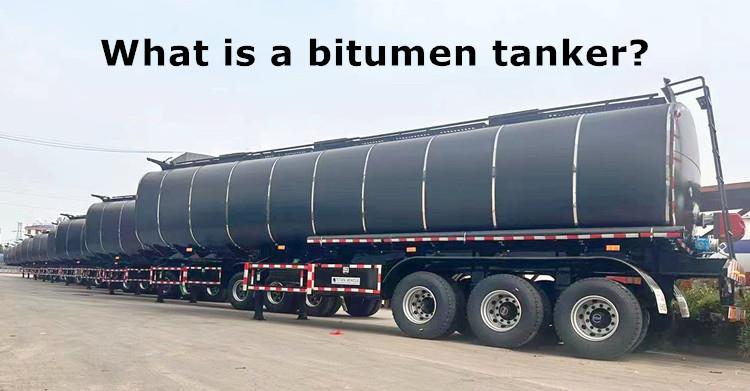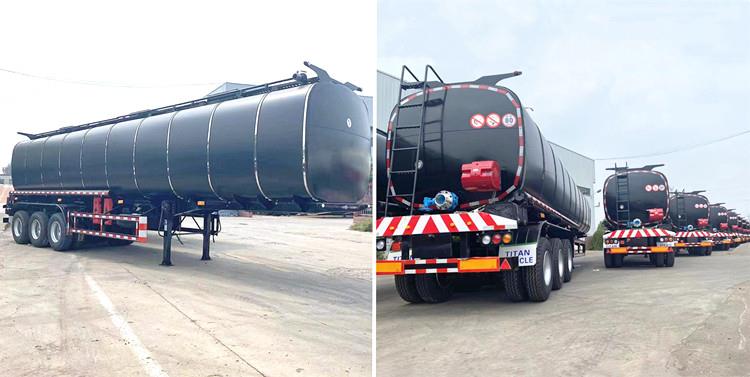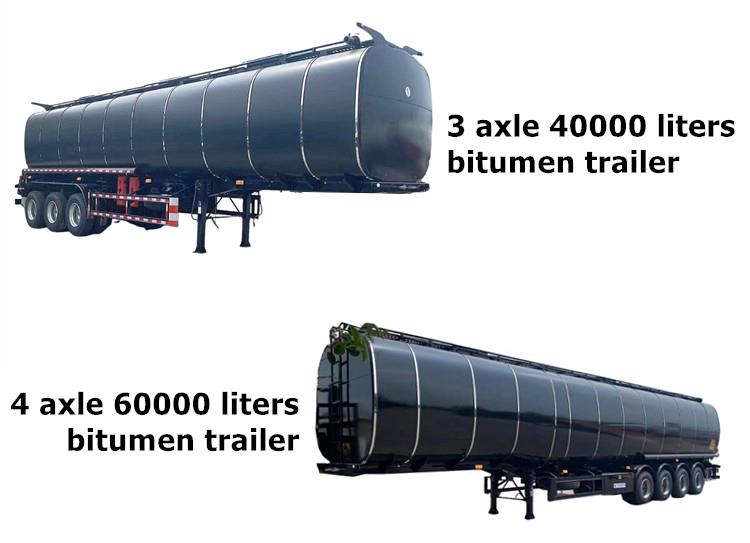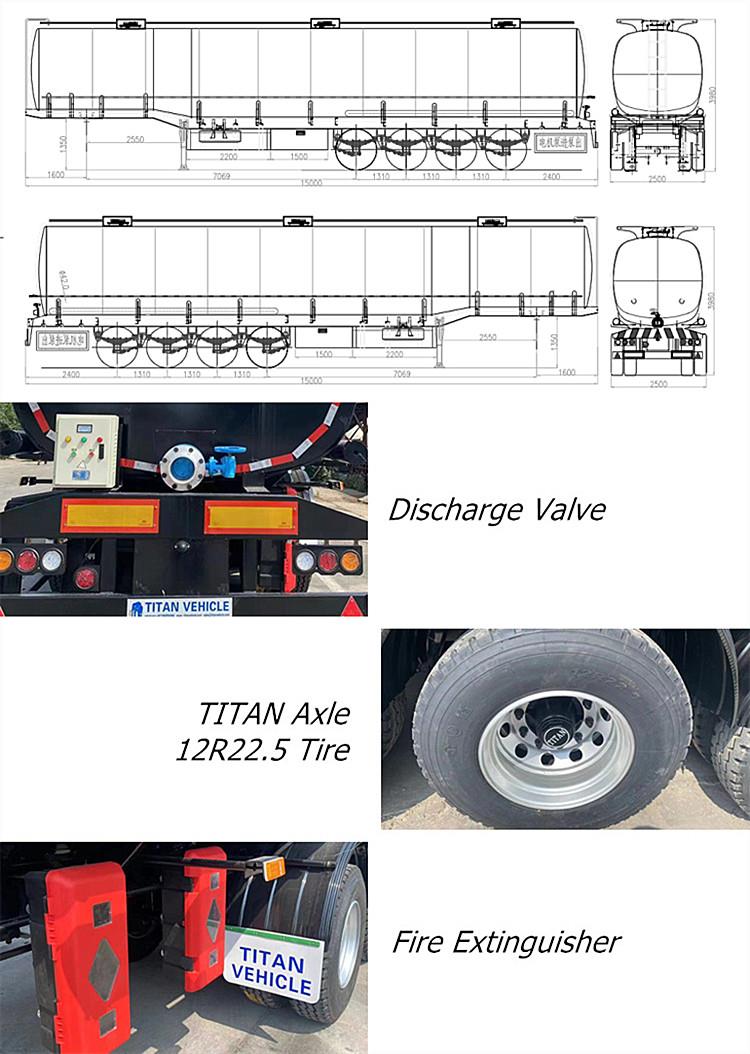Table of Contents
Chapter 1: What is a bitumen tanker?
Chapter 2: How is bitumen transported?
Chapter 3: What is the classification of a tanker trailer?

A bitumen tanker is a type of tanker trailer specifically designed for the transportation of bitumen. Large-scale industries and factories use bitumen tanker to transport huge amounts easily and quickly. Bitumen tanker trailers with 2 to 4 axles and the tank body is designed differently. The design of bitumen tanker body is according to different steel needs and desired thickness.
Bitumen tankers have insulated tanks to keep the bitumen at a high temperature during transportation, as it needs to be kept in a liquid state. These tankers are equipped with specialized heating systems to maintain the temperature of the bitumen and ensure it remains in a suitable condition for its various applications.
TITAN Vehicle is a bitumen tanker manufacturer from China. We provide 38000-60000 liters and more bitumen tanker for sale in Papua New Guinea. We can customize it according to your needs.

Operating bitumen tanker is not an easy task. The drivers are well trained and experienced before taking on long journeys of transporting liquid bitumen. Safe handling by end workers and tanker trailer drivers is of high importance. The high temperature of the bitumen and driving hazards in different climate conditions pose a challenge.
The bitumen tank must go through proper inspection before loading. The tank should be clean of debris and other contaminants. In case there is moisture in the tank, the bitumen mixed into it will cause foaming. This foam, when formed, may cause harmful fumes to leave the tank and the operator will be affected.
Loading
The following are several things that all operators need to keep in mind when loading bitumen into the tank of the bitumen tanker trailer.
Ensuring that the chain covers are in the right places on the rotating drives so there is no chance of entanglement.
The combustion sources are well-lit and nowhere near open manholes or overflow vents. This ensures there are no fire hazards.
The distributor motor is on before the value is opened.
Before opening the storage tank, the loading hose must be attached properly and the bleeder valve should be closed.
Ensuring that no one is standing close to the valves which may open. This is an added safety measure.
Once everything is in place, open the valve on the storage tank and pump the desired amount of bitumen at a slow rate. This rate should be appropriate, neither too high nor too low.
Once the bitumen is finished filling in the tank, the storage valve is closed and the bleeder valve is opened. The pump must continue to work so that all residue of bitumen is out of the hose.
The tank must have enough space for the expansion of the bitumen when it is heated.
Once the hose is clear of all bitumen residue; the hose is disconnected and placed back properly in its storage location. The bleeder valve is closed and locked.
The bitumen levels present on the tank and gauges are also needed to be checked to ensure that sufficient quantity is loaded in the tank.

Unloading
While unloading bitumen from bitumen tanker for sale, the operator must ensure that, the chain covers are in their rightful places to avoid possible entangling. The sources of lit combustion must be clear of overflowing bitumen to prevent any fire hazards. Other things to keep in mind during unloading are:
Checking whether the storage tank is with sufficient capacity.
The unloading pipe is attached to the truck, and the bleeder valve is closed. Once this is in place, the operator will unlock the storage tank.
The valve of the storage tank pump is opened and the desired amount is filled at the right rate.
Once the unloading is completed, the distributor adjustments are made following the operations manual, and the valve is closed.
Every operator must follow the unloading instructions according to the model of the sucking pipe. The pipe must be cleared out of any residue bitumen by the bleeder valve.
Once all the steps are finished properly, the pipe should be disconnected from the distributor and placed back in its storage place. The valve on the tank must be locked and the bleeder valve closed.

Tanker trailers can be classified based on various factors such as their purpose, design, capacity, and construction material. Here are a few common classifications:
1. Fuel Tanker: Designed for transporting different types of liquid fuels such as gasoline, diesel, or aviation fuel. They often have multiple compartments to carry different fuel types.
2. Chemical Tanker: Specifically designed for transporting various chemicals, including hazardous and non-hazardous substances. These tankers are built with materials that are resistant to the chemicals being transported.
3. Food-Grade Tanker: Used for transporting food products such as milk, edible oils, juices, or liquid sweeteners. These tankers are constructed to meet strict hygiene and safety standards to maintain the integrity and quality of the food items.
4. Dry Bulk Tanker: Designed to transport bulk solids such as cement, grains, sand, or plastic pellets. These tankers usually have a large capacity and special discharge systems for easy unloading.
5. Bitumen Tanker: Used for transporting bitumen or asphalt, which is commonly used in road construction. These tankers are insulated and have heating systems to keep the bitumen in a liquid state.
These are just a few examples, and there are various other types of tankers designed to transport specific materials.